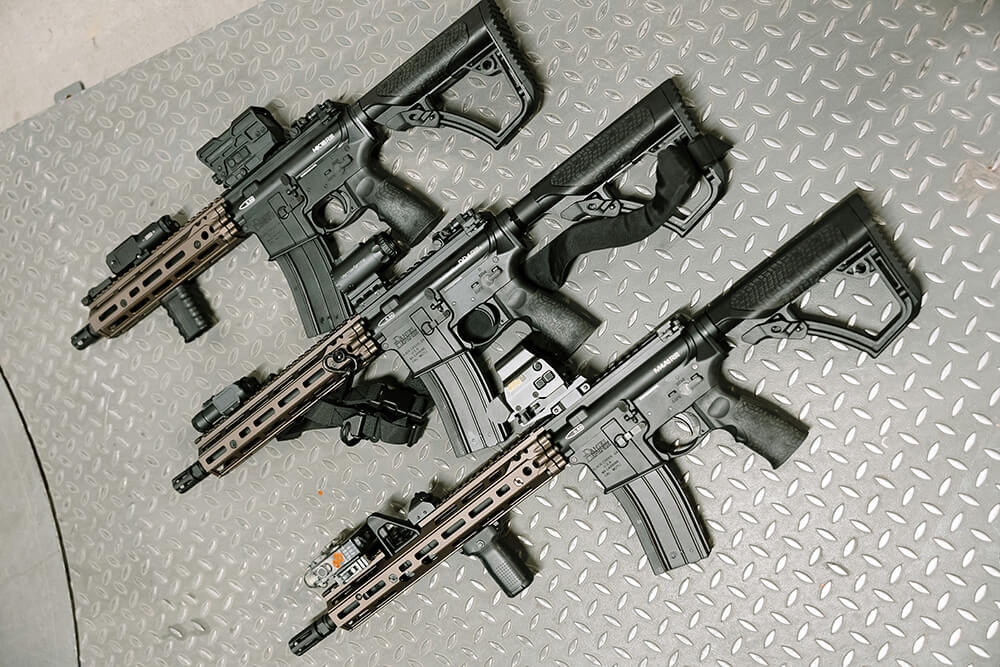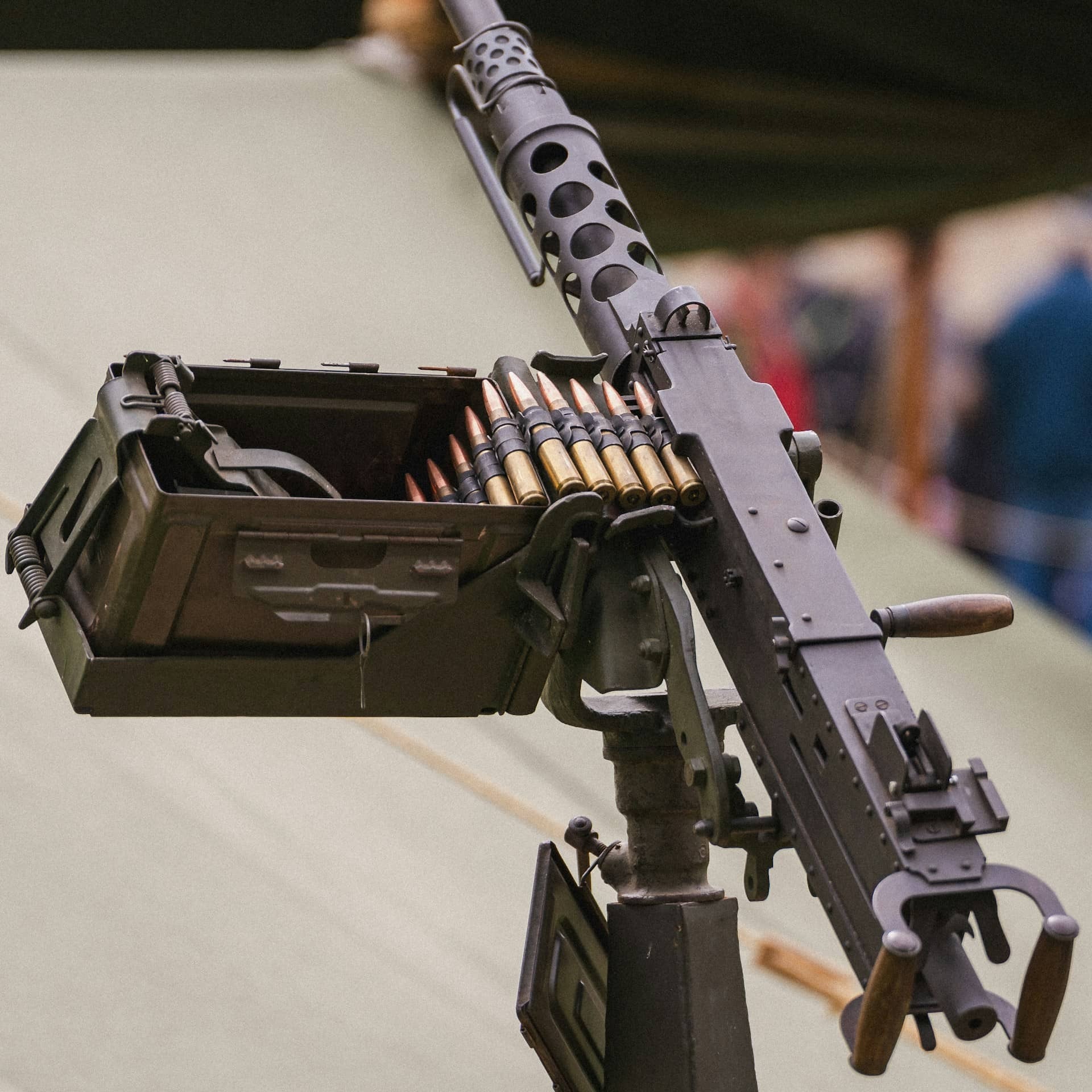
- There are five major variations of firearms.
- Rifles and shotguns share common variations, but not ammunition.
- Specialized firearms tend to be relatively niche designs.
History and the modern firearms market are full of guns. But that leaves the question “How many types of guns are there?” And the answer is a little daunting.
Wing Tactical is dedicated to keeping you informed about firearms, so we will do our best to cover the different types of guns.
Guns by Firearms Style
There are roughly five major variations of guns. This does not include different types of ammunition, caliber, bolt styles, or other design factors, as that would rapidly expand into dozens of categories across hundreds of firearms models. We are going to focus on the basic variations and some of their subcategories.
Handguns
These types of guns are the ones you will most likely see in public. Police, security guards, and even private citizens are often armed with some kind of handgun. Add in movies and television, and most people have seen numerous models of handguns. The two primary handgun styles are revolvers and semi-automatics.
Revolvers
Revolvers are one of the older firearm designs. They have a rotating cylinder and can hold anywhere from 5 to 10 rounds, depending on the caliber and cylinder design. There are several barrel lengths, and they can be used for everything from self-defense to hunting, as long as the right round and barrel length are used.
Semi-automatics
The next modern handgun is the semi-automatic (semi-auto). These became popular around 1900, and multiple designs were developed and refined over the next hundred years. Semi-automatics would become popular with civilians and law enforcement over revolvers after the 1980s.
They are often fed with a removable magazine and chamber the next round with the extra energy generated from firing a shot. This allows for faster-firing guns depending on the trigger and the shooter.
Semi-autos usually have higher capacities than revolvers, with small-sized semi-autos having 7-10 round capacities and larger versions having 15-17 rounds standard. They are often used for self-defense and duty use, with mild usage in hunting roles.
|
Handgun actions |
Handgun Styles |
|
Single Action |
Revolvers Older hammer-fired semi-autos |
|
Double Action Only |
Most Striker-fired pistols Some Revolvers Some Hammer-fired semi-autos |
|
Double Action/Single Action (DA/SA or Triple Action) |
Most modern revolvers Hammer-fired semi-autos |
Rifle Styles
When it comes to long-distance effectiveness and general accuracy, the rifle is the primary gun to use. It comes in a number of styles: bolt actions, lever actions, break/single actions, pump actions, semi-automatic, and select fire.
Bolt Action Rifles
When it comes to a common manual action, the bolt-action rifle is the king. Bolt-action rifles are powered by you. The two primary types are rotary bolts and straight pulls. These actions are known for being used with precision rifles and are commonly found on hunting rifles, sniper rifles, and target rifles.
Lever Actions
If you grew up watching Westerns, you’ll recognize a lever action. These were developed in the late 1800s, and their versatility and nostalgia have kept them alive right up to the modern day. They have a lot of social acceptance and can be chambered in a wide variety of calibers.
Lever actions are commonly used for hunting, competition, and self-defense. Some companies are even making modern accessories to bring the platform into the modular future.
Break Action/Single Shot
These are some of the highest skill-based rifles since they only have one or two shots available. The older hunting designs are often related to elephant guns but can be chambered in more common calibers. They often resemble shotguns and are usually very expensive.
Pump Action Rifles
Not as common as lever actions, but pump-action rifles are still good hunting rifles. They are more streamlined than bolt actions and more linear than lever actions. Most modern pump-action rifles are chambered in .22 Long Rifle and used for hunting and plinking (recreational) shooting.
Semi-Automatic Rifles
These are some of the most common rifles on the market. They are often selected for self-defense, hunting, and police work. There are a number of variations ranging from more traditional hunting rifles to more modern designs like the AR-15, which dominates the US market.
While many of these work on the same principles, this does not mean they have interchangeable parts. Many modern rifles have distinct lineages, which make them unique. For example, AK-47 parts are not wholly interchangeable with AR-15 parts, although there are some adapters developed so they can share buttstock styles.
Select Fire Rifles
While they are restricted by licensing for the civilian population, select-fire rifles are common to most militaries. This means the rifle can fire one round at a time or multiple rounds once a secondary setting has been selected. The two most common settings are 3-round burst or full automatic.
| Common Rifle Types |
|
Shotguns
There is very little argument that the most popular gun on the planet that can do the most is the shotgun. From hunting to law enforcement to the military, a shotgun in some form has been optimized to do a job and then be able to handle four more.
They are found in similar configurations as rifles, which include break actions, pump actions, semi-automatics, and lever actions.
Break actions
These shotguns hinge in front of their breech, requiring the user to put in new ammunition by hand. These styles of shotguns date back to the mid-1800s and can be found with one, two, or even three barrels.
These styles of shotguns are popular for hunting, trap shooting, and cowboy action competitions.
Pump Action Shotguns
The most common type of shotgun you will encounter is a pump-action. These shotguns were developed in the late 1800s, coming to prominence in the 1900s as both a solid hunting gun and a combat arm.
Today, most pumps are some variant of Remington 870 or Mossberg 500/590. Pump actions are used for self-defense, hunting, breaching, and recreational shooting.
Semi-Automatic
Semi-automatic shotguns often have a means for recoil mitigation. The Browning Auto-5 was the first successful semi-auto shotgun back in 1902. From then, various designs have been made with the Benelli company producing some of the most popular styles.
Semi-auto shotguns are used primarily for self-defense, law enforcement, hunting, and special military roles. They are much faster firing than a pump action, but can be very ammunition sensitive, since the gun is cycled by the ammunition.
Lever-Action Shotguns
While not as common, lever-action shotguns do exist; most modern options are chambered in .410, while the few historical examples tend to be chambered in 12 or 20 gauge. These guns work similarly to lever-action rifles, but with lower-pressure shotgun shells instead of pistol or rifle calibers.
These are often used for hunting and recreation, although self-defense is still an option.
| Shotgun Styles |
|
Specialized Firearms

Special firearms are those that step outside of the three basic firearm groups. These either blend specific features together or fill roles that a handgun, rifle, or shotgun can’t or won’t fill.
Pistol Caliber Carbines
A pistol caliber carbine (PCC) is either a semi-automatic or lever-action gun that is chambered in a pistol caliber. They are more controllable than pistols due to their rifle-like ergonomics, but have some quirks that can make them more uncomfortable to shoot than rifles.
PCCs are commonly used in competitions and selected for home defense for individuals who either have ammunition concerns or have specific weight needs in mind. Some are even compatible with certain Glock parts like magazines.
Submachine guns
When it comes to niche firearms, very few things have the “cool factor” of submachine guns. Submachine guns are usually larger than pistols but smaller than rifles. They are either full auto or select fire. This means they can provide a lot of firepower in close-in environments.
Because of this compact automatic fire, submachine guns are primarily used by special units in both military and law enforcement settings. They are highly collectible, but due to their cost and availability, most people will get a semi-automatic clone instead.
Machine guns
This special type of gun is usually used by the military. Modern variations are almost entirely open bolt, belt-fed guns with full auto capabilities. Machine guns are chambered in intermediate and full-power cartridges. This makes them much heavier than a common hunting rifle.
They are designed specifically for combat and suppressive fire. That being said, there are some locations that allow you to fire them recreationally. If you truly enjoy firearms and can afford the experience, it is recommended that you try it.
Closing Thoughts
Whether it’s the guns themselves, the hobbies attached to them, or their history and development, some people spend most of their lives in pursuit of learning more and more about guns. Wing Tactical hopes this article helped you on your journey to learn more about firearms.
If you have any questions about our products or any of the brands we offer, feel free to contact us via our Contact Us page. Check out our wide variety of gun parts to upgrade your next firearm.